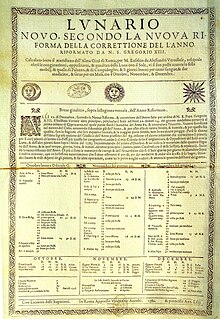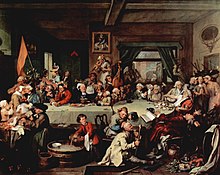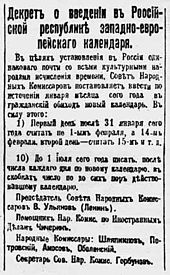Adoption of the Gregorian calendar: Difference between revisions
added Drenthe and supplied more exact dates |
|||
| Line 26: | Line 26: | ||
</ref> |
</ref> |
||
In the 1690s, [[Ole Rømer]] used his influence to bring about a uniform adoption of the Gregorian calendar in Protestant countries, though that could not be achieved in practice. Denmark, which then included Norway and some Protestant states of present-day Germany, adopted the solar portion of the new calendar with Sunday, 18 February 1700, being followed by Monday, 1 March 1700.<ref name=NT-Perpetual-Calendar>Nørby, Toke. [http://www.norbyhus.dk/calendar.php The Perpetual Calendar]</ref> Prussia adopted the Gregorian calendar on the same day. Denmark did not adopt the [[Computus|lunar portion]] but decided to calculate the date of Easter astronomically using the instant of the vernal equinox and the full moon according to [[Johannes Kepler|Kepler]]'s ''[[Rudolphine Tables]]'' of 1627. They finally adopted the lunar portion of the Gregorian calendar in 1776. The remaining provinces of the [[Dutch Republic]] adopted the Gregorian calendar |
In the 1690s, [[Ole Rømer]] used his influence to bring about a uniform adoption of the Gregorian calendar in Protestant countries, though that could not be achieved in practice. Denmark, which then included Norway and some Protestant states of present-day Germany, adopted the solar portion of the new calendar with Sunday, 18 February 1700, being followed by Monday, 1 March 1700.<ref name=NT-Perpetual-Calendar>Nørby, Toke. [http://www.norbyhus.dk/calendar.php The Perpetual Calendar]</ref> Prussia adopted the Gregorian calendar on the same day. Denmark did not adopt the [[Computus|lunar portion]] but decided to calculate the date of Easter astronomically using the instant of the vernal equinox and the full moon according to [[Johannes Kepler|Kepler]]'s ''[[Rudolphine Tables]]'' of 1627. They finally adopted the lunar portion of the Gregorian calendar in 1776. The remaining provinces of the [[Dutch Republic]] adopted the Gregorian calendar on 12 July 1700 (Gelderland), 12 December 1700 (Overijssel and Utrecht), 12 January 1701 (Friesland and Groningen) and 12 May 1701 (Drenthe). |
||
[[File:Almanacka 1753.jpg|thumb|Swedish ''[[Almanach]]'' of 1753]] |
[[File:Almanacka 1753.jpg|thumb|Swedish ''[[Almanach]]'' of 1753]] |
||
Revision as of 09:13, 9 April 2015

The Gregorian calendar was decreed in 1582 by the papal bull Inter gravissimas by Gregory XIII. Although Gregory's reform was enacted in the most solemn of forms available to the Church, the bull had no authority beyond the Catholic Church and the Papal States. The changes that he was proposing were changes to the civil calendar, over which he had no authority. They required adoption by the civil authorities in each country to have legal effect.
The bull became the law of the Catholic Church in 1582, but it was not recognised by Protestant Churches, Orthodox Churches, and a few others. Consequently, the days on which Easter and related holidays were celebrated by different Christian Churches again diverged.
A month after having decreed the reform, the pope with a brief of 3 April 1582 granted to Antoni Lilio, the brother of Luigi Lilio, the exclusive right to publish the calendar for a period of ten years. The Lunario Novo secondo la nuova riforma printed by Vincenzo Accolti, one of the first calendars printed in Rome after the reform, notes at the bottom it was signed with papal authorization and by Lilio (Con licentia delli Superiori... et permissu Ant(onii) Lilij). The papal brief was later revoked, on 20 September 1582, because Antonio Lilio proved unable to keep up with the demand for copies.[1]
Adoption in Catholic countries
Philip II of Spain decreed the change from the Julian to the Gregorian calendar, which affected much of Roman Catholic Europe, as Philip was at the time ruler over Spain and Portugal as well as much of Italy. In these territories, as well as in the Polish–Lithuanian Commonwealth (ruled by Anna Jagiellon) and in the Papal States, the new calendar was implemented on the date specified by the bull, with Julian Thursday, 4 October 1582, being followed by Gregorian Friday, 15 October 1582; the Spanish and Portuguese colonies followed somewhat later de facto because of delay in communication.[2]
Other Catholic countries soon followed. France adopted the new calendar with Sunday, 9 December 1582, being followed by Monday, 20 December 1582.[3] The Dutch provinces of Brabant, Zeeland, and the Staten-Generaal adopted it on 25 December of that year; the provinces forming the Southern Netherlands (modern Belgium) except the Duchy of Brabant adopted it on 1 January 1583; the province of Holland adopted it on 12 January 1583.[citation needed]
Adoption in Protestant countries
Many Protestant countries initially objected to adopting a Catholic innovation; some Protestants feared the new calendar was part of a plot to return them to the Catholic fold.[4] In the Czech lands, Protestants resisted the calendar imposed by the Habsburg Monarchy. In parts of Ireland, Catholic rebels until their defeat in the Nine Years' War kept the "new" Easter in defiance of the English-loyal authorities; later, Catholics practising in secret petitioned the Propaganda Fide for dispensation from observing the new calendar, as it signalled their disloyalty.[5]
In the 1690s, Ole Rømer used his influence to bring about a uniform adoption of the Gregorian calendar in Protestant countries, though that could not be achieved in practice. Denmark, which then included Norway and some Protestant states of present-day Germany, adopted the solar portion of the new calendar with Sunday, 18 February 1700, being followed by Monday, 1 March 1700.[6] Prussia adopted the Gregorian calendar on the same day. Denmark did not adopt the lunar portion but decided to calculate the date of Easter astronomically using the instant of the vernal equinox and the full moon according to Kepler's Rudolphine Tables of 1627. They finally adopted the lunar portion of the Gregorian calendar in 1776. The remaining provinces of the Dutch Republic adopted the Gregorian calendar on 12 July 1700 (Gelderland), 12 December 1700 (Overijssel and Utrecht), 12 January 1701 (Friesland and Groningen) and 12 May 1701 (Drenthe).

Sweden's relationship with the Gregorian calendar was a difficult one. Sweden started to make the change from the Julian calendar and towards the Gregorian calendar in 1700, but it was decided to make the (then 11-day) adjustment gradually by excluding the leap days (29 February) from each of 11 successive leap years, 1700 to 1740. Meanwhile, the Swedish calendar would be out of step with both the Julian calendar and the Gregorian calendar for 40 years; also, the difference would not be constant but would change every four years. This system had potential for confusion when working out the dates of Swedish events in this 40-year period. To add to the confusion, the system was poorly administered, and the leap days that should have been excluded from 1704 to 1708 were not excluded. The Swedish calendar (according to the transition plan) should have been 8 days behind the Gregorian but was 10 days behind. King Charles XII recognised that the gradual change to the new system was not working, and he abandoned it. Rather than proceeding directly to the Gregorian calendar, it was decided to revert to the Julian calendar. This was achieved by introducing the unique date 30 February in 1712, adjusting the discrepancy in the calendars from 10 back to 11 days. Sweden finally adopted the Gregorian calendar in 1753, when Wednesday, 17 February, was followed by Thursday, 1 March. Since Finland was under Swedish rule at that time, it did the same.[7] Finland's annexation to the Russian Empire did not revert this, since autonomy was granted, but government documents in Finland were dated in both the Julian and Gregorian styles. This practice ended when independence was gained in 1917.

Through enactment of the Calendar (New Style) Act 1750, Britain and the British Empire (including the eastern part of what is now the United States) adopted the Gregorian calendar in 1752, by which time it was necessary to correct by 11 days. Wednesday, 2 September 1752, was followed by Thursday, 14 September 1752. Claims that rioters demanded "Give us our eleven days" grew out of a misinterpretation of a painting by William Hogarth. After 1753, the British tax year in Britain continued to operate on the Julian calendar and began on 5 April, which was the "Old Style" new tax year of 25 March. A 12th skipped Julian leap day in 1800 changed its start to 6 April. It was not changed when a 13th Julian leap day was skipped in 1900, so the tax year in the United Kingdom still begins on 6 April.
In Alaska, the change took place when Friday, 6 October 1867, was followed again by Friday, 18 October, after the US purchase of Alaska from Russia, which was still on the Julian calendar. Instead of 12 days, only 11 were skipped, and the day of the week was repeated on successive days, because the International Date Line (although not known by that name in 1867) was shifted from Alaska's eastern to western boundary along with the change to the Gregorian calendar.[8]
Adoption in Eastern Europe

The Kingdom of Bulgaria changed from the Julian to the Gregorian calendar during the First World War on 31 March 1916, where the next day was 14 April 1916.[9]
In Russia the Gregorian calendar was accepted after the October Revolution (so named because it took place in October 1917 in the Julian calendar). On 24 January 1918 the Council of People's Commissars issued a Decree that Wednesday, 31 January 1918, was to be followed by Thursday, 14 February 1918, thus dropping 13 days from the calendar.
Other countries of Eastern Europe, most notably Orthodox countries, adopted the Gregorian calendar in the 1910s or early 1920s. The last country of Eastern Orthodox Europe to adopt the Gregorian calendar was Greece, at the time under military administration following the 1922 revolution, with Wednesday 15 February 1923 being followed by Thursday 1 March 1923.[10] The Soviet decree expressly limited the reform to lay (i.e. non - religious) matters. None of these reforms affected the dates of religious holidays.
Adoption in East Asia
Japan decided to officially replace its traditional lunisolar calendar with the Gregorian calendar in 1872, so the day following the second day of the twelfth month of the fifth year of the Meiji emperor's rule, became 1 January 1873. (The Japanese rendering of the Western months is simply ichi-gatsu="One-month" for January, ni-gatsu="Two-month" for February, etc.[11]) This brought Japan's calendar in alignment with that of the major Western powers (excluding Russia). To this day, however, it is common to use Nengo, reign names instead of the Common Era or Anno Domini system, especially for official documents; for instance, Meiji 1=1868, Taisho 1=1912, Showa 1=1926, Heisei 1=1989, and so on. Still, this system has increasingly been replaced in popular usage by the "Western calendar" (西暦, seireki) over the course of the twentieth century.[citation needed]
Korea adopted the Gregorian calendar on 1 January 1895 with the active participation of Yu Kil-chun.[12] Although the new calendar continued to number its months, there were multiple systems used to refer to its years: during the Joseon Dynasty, in 1895–97, its years were numbered from the founding of that dynasty, regarding 1392 as year one;[13] then between 1897 and 1910, and again from 1948 to 1962, Korean era names were used for its years; and between 1910 and 1945, when Korea was under Japanese rule, Japanese era names were used to count the years of the Gregorian calendar used in Korea.[citation needed]
In South Korea, from 1945 until 1961, Gregorian calendar years were also counted from the foundation of Gojoseon in 2333 BC (regarded as year one), the date of the legendary founding of Korea by Dangun, hence these Dangi (단기) years were 4278 to 4294. This numbering was informally used with the Korean lunar calendar before 1945 but is only occasionally used today.
The Republic of China (ROC) formally adopted the Gregorian calendar at its founding on 1 January 1912, but China soon descended into a period of warlordism with different warlords using different calendars. With the unification of China under the Kuomintang in October 1928, the Nationalist Government decreed that effective 1 January 1929 the Gregorian calendar would be used. China retained the Chinese traditions of numbering the months and a modified Era System, backdating the first year of the ROC to 1912; this system is still in use in Taiwan where the ROC government retains control. Upon its foundation in 1949, the People's Republic of China continued to use the Gregorian calendar with numbered months, but abolished the ROC Era System and adopted Western numbered years.
Non-adoption by Orthodox Churches
While the civil administrations of Eastern European countries adopted the Gregorian calendar in the 1910s or early 1920s, none of the national Orthodox Churches have recognised the Gregorian calendar for church or religious purposes. Instead, a Revised Julian calendar was proposed in May 1923 which dropped 13 days in 1924 and adopted a different leap year rule. There will be no difference between the two calendars until 2800.
The Orthodox churches of Jerusalem, Russia, Serbia, Georgia, Poland, Macedonia and the Greek Old Calendarists did not accept the Revised Julian calendar, and continue to celebrate Christmas on 25 December in the Julian calendar, which is 7 January in the Gregorian calendar until 2100.
All of the other Eastern churches, the Oriental Orthodox churches (Coptic, Ethiopian, Eritrean, and Syrian) continue to use their own calendars, which usually result in fixed dates being celebrated in accordance with the Julian calendar. This is most interesting in the case of the Syriac Orthodox Church, as one of its Patriarchs Ignatius Nemet Allah I was one of the nine scholars who devised the Gregorian calendar.[14] The Indian Orthodox Church uses the Gregorian calendar along with their autonomous Syriac Orthodox counterparts in India, the Jacobite Syriac Orthodox Church.
The Armenian Apostolic Church adopted the Gregorian calendar in 1923, except in the Armenian Patriarchate of Jerusalem, where the old Julian calendar is still in use.[15][16]
Present situation
Today, the vast majority of countries use the Gregorian calendar as their sole civil calendar. Countries which have not adopted the Gregorian calendar include Saudi Arabia, Ethiopia, Nepal, Iran and Afghanistan. Some countries use other calendars alongside the Gregorian calendar, including India, Bangladesh, Pakistan, Israel and Burma;[17] and other countries use a modified version of the Gregorian calendar, including Thailand, Japan, North Korea and Taiwan.
While many religious organizations reckon their liturgical year by the Gregorian civil calendar, others have retained their own calendars. Alternate calendars are used in many regions of the world today to mark cycles of religious and astrological events.
Timeline

The date when each country adopted the Gregorian calendar, or an equivalent, is marked against a horizontal time line. The vertical axis is used for expansion to show separate national names for ease in charting, but otherwise has no significance.
Notes
- ^ Mezzi, E., and Vizza, F., Luigi Lilio Medico Astronomo e Matematico di Cirò, Laruffa Editore, Reggio Calabria, 2010, p. 14; p. 52, citing as primary references: Biblioteca Nazionale Centrale die Firenze, Magl. 5.10.5/a, ASV A.A., Arm. I‑XVIII, 5506, f. 362r.
- ^ "Pragmatica" on the Ten Days of the Year World Digital Library, the first known South American imprint, produced in 1584 by Antonio Ricardo, of a four-page edict issued by King Philip II of Spain in 1582, decreeing the change from the Julian to the Gregorian calendar.
- ^ "Toke Nørby. The Perpetual Calendar: What about France?". Norbyhus.dk. Retrieved 2010-09-14.
- ^ Moyer (1982).
- ^ Morgan, Hiram (1 April 2006). "'The Pope's new invention': the introduction of the Gregorian calendar in Ireland, 1583–1782" (MS Word). Pontifical Irish College, Rome: "Ireland, Rome and the Holy See: History, Culture and Contact", a UCC History Department symposium. Retrieved 17 October 2010.
- ^ Nørby, Toke. The Perpetual Calendar
- ^ Mike Spathaky Old Style and New Style Dates and the change to the Gregorian Calendar: A summary for genealogists
- ^ Sumner 1875, p. 348
- ^ See "Закон за въвеждане на Грегориянския календар [Law on Introduction of the Gregorian Calendar]", Държавен вестник [Durzhaven Vestnik (State Gazette)], vol. XXXVII, Sofia, 21 March 1916
{{citation}}: CS1 maint: location missing publisher (link) - ^ US Social Security Administration 2005.
- ^ "About Japanese Vocabulary - Calendar". About.com. Retrieved 23 Apr 2014.
- ^ Lee (1996), p. 341.
- ^ Lee (1996), p. 382 and p. 520 (note 13).
- ^ Barsoum (2003)
- ^ The Armenian Church | Christmas (c. 2010). Diocese of the Armenian Church of America (Eastern).
- ^ Ardem A. Tajerian (n.d.). When Is Easter This Year? CAKE Foundation. Retrieved 7 January 2009.
- ^ Mughal (2014)
Works cited
- Lee, Peter H. (Ed.) (1996). Sourcebook of Korean Civilization: Vol.2: From the seventeenth century to the modern period. Columbia University Press. ISBN 0-231-07914-1.
- Lee, P.H. & de Bary, W. T. (Eds., with Yongho Ch'oe & Kang, H. H. W.) (2000). Sources of Korean Tradition, (Vol. 2). New York: Columbia University Press.
- Mughal, Muhammad Aurang Zeb (2014). "Calendars Tell History: Social Rhythm and Social Change in Rural Pakistan". History and Anthropology 25(5): 592-613.
- Neuru, L. L. (1996) "St. Valentine's Holiday". Labyrinth, 64.
- Sumner, Charles. (1875). The cession of Russian America to the United States in The Works of Charles Sumner, vol. 11. Boston: Lea and Shepard.
- US Social Security Administration. (2005). "Gregorian/Julian Calendar" in Program Operations Manual System.
